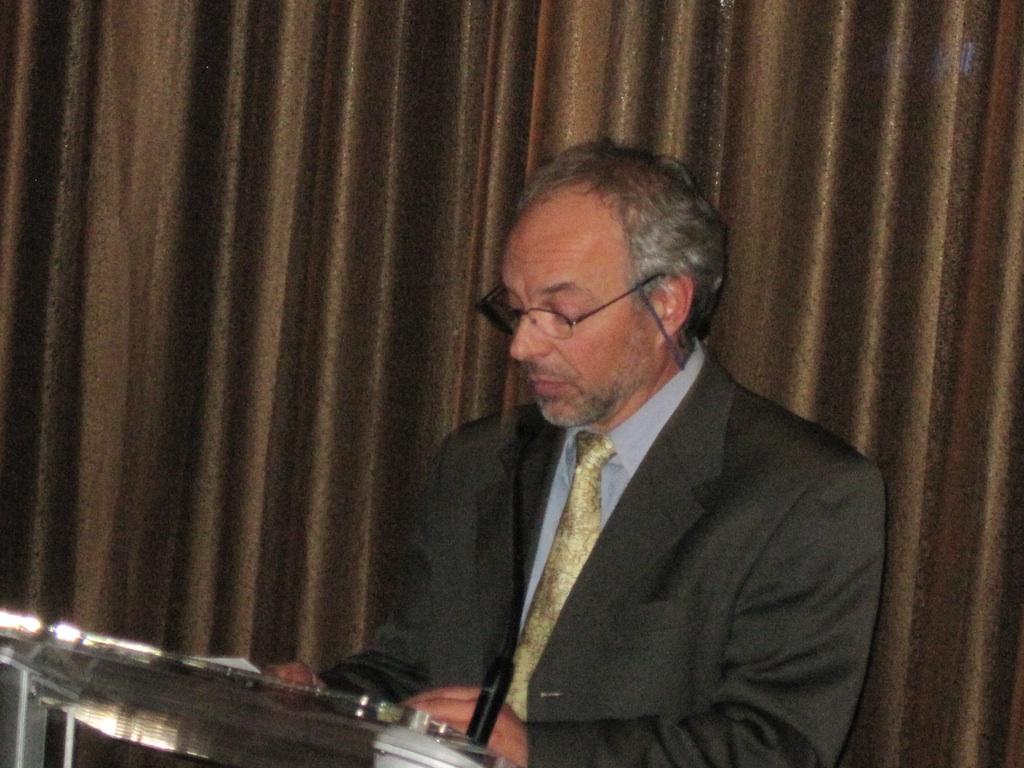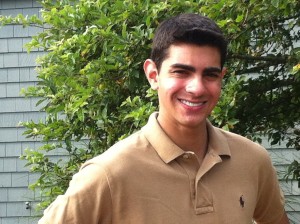I think it’s safe to say that we live in a world of complicated problems—conglomerate and dynamic messes that no one really knows how to clean up. These universal issues are so muddy, so inscrutable, that they’re often simplified into impossible generalities, like stopping crime, or fixing the environment. And if that weren’t enough, local organizations and federal and international forces become bogged down in short-term goals and analyses. When such issues become so general or so narrow in focus, we often lose sight of exactly what needs to be done and how it should be done to solve the problem. Ocean conservation is just one of the many issues we face, and it’s no easier to understand.
Two weeks ago, on Thursday, November 14th, I had the pleasure of attending the annual Blue Ocean Institute gala fundraiser. Blue Ocean Institute is a nonprofit organization that seeks to maintain marine ecosystems and biodiversity. Founded in 2003 by conservationist, author and journalist, Dr. Carl Safina, BOI is known not only for its effective use of funds, but for its multidisciplinary approach to conservation. In the last several years, the organization has raised money and awareness, kick-started far-reaching educational programs at Stony Brook and across the country, rallied a community of writers, artists, chefs, photographers, teachers, and scientists to pursue conservation efforts all over the globe. They’ve faced issues as diverse as seafood sustainability and fracking.
The gala benefit, which took place at the Riverpark restaurant in Manhattan, celebrated Blue Ocean Institute’s 10th anniversary—a decade of roaring success and growth for the organization. The gala featured a fundraising auction of nautical artwork, and a program of performers and speakers. After a delicious dinner of sustainable trout, the program began with a lovely original piece played by Grammy-award winning jazz musician Paul Winter. Then, we got a chance to hear from the Blue Ocean Fellows, distinguished allies of the institute who have worked to pursue its mission statement in pioneering ways.
The first Fellow to speak was Andrew Revkin, an environmental journalist who has written for the New York Times for nearly 18 years. After discussing some of his recent works, Andy praised Dr. Safina’s innovative approach to conservation: “Carl has really kind of captured, I think, the idea that there are so many aspects to sustainability that come back to the person, to yourself.”
The next Fellow to speak was Paul Greenberg, a New York Times Bestselling author of conservation works and a longtime journalist for the Times, National Geographic, and countless other publications and organizations. Paul discussed our relationship with seafood—an obfuscating term that he called “a blunt instrument used to describe an incredibly diverse world system, ecosystem, and food system.” He attributed the global loss of touch with our marine habitat, in part, to detached terms like ‘sea food’. Then, as his speech concluded, he thanked Dr. Safina for his efforts in “removing the blunt instrument” and “expanding our thoughts about how we eat from the sea, [and] how we live with the sea”—in other words, for working to remove deceptive generalizations and broadening our scope of understanding.
The last Fellow to speak was John Weller, a brilliant writer, photographer and filmmaker, and kickstarter of The Last Ocean project, who had spent the last decade conducting conservation efforts in the Ross Sea, Antarctica. He discussed his past adventures in the arctic, and his new mission to prevent destructive fishing practices in the Raja Ampat islands in Indonesia. He expounded on how “industrialized fishing is ravaging the region in response to exploding markets for shark fins and reef fish. In the last fifty years,” he explained, “dynamite blasts have pulverized the reefs of entire island chains, and sheltered coves are far too often littered with the discarded bodies of finned sharks—the waste from roving camps of sharkfinners.” Poachers often illegally cut away the fins of sharks to sell in a booming market for shark fin soup and other products, with drastic implications. John is beginning a project in which he and other conservationists will showcase an informative video of the issue on a huge mobile screen across the islands, in an effort to raise local awareness of the problems at hand.
These three Fellows are pursuing short-term goals in pursuit of the institute’s larger mission to maintain sustainable marine practices. With a quest as broad as ceasing gun violence or preventing terrorism, one might ask whether or not the questions of what must be done and how it will be accomplished are just as lost. But Blue Ocean Institute sees the path to its destination clearly, even through the grime and the mud.
Dr. Carl Safina spoke next. He began his speech by tackling the question of what exactly Blue Ocean Institute does. How did the longtime conservationist answer the deceptively simple question, and compile the group’s countless and far-reaching projects into a single purpose? “We witness,” he began, “firsthand, how nature is changing around the world, then we explain what the changes mean for wildlife and for people.” They observe and they assess, like scientists, and then “show how we could make a better deal with nature and with one another…we’re helping envision and deliver a new conservation ethic for the 21st century. With a special emphasis on the sea, we’re working to inspire a deeper connection between people and nature.” By observation and conveyance, they seek to “enlighten personal choices, support better policies, and build a larger constituency for conservation”. So, in short, Blue Ocean institute has the what answered.
But then there’s the how. This is a set of epic goals. How does BOI achieve them? “We do this,” Dr. Safina explained, “by making things that people can see, have, and share. We do this by what we write, say, show…through literature, science, teaching; by writing unique books, conveying new stories, doing applied conservation research…We do this by showing the beauty, and what’s at stake.” Through their many projects and collaborations, Blue Ocean Institute pursues its larger cause systematically. In other words, it’s answered the how.
We can glean insights from conservation efforts when dealing with or trying to understand other global issues, for in every one, the what and the how must be answered. But the connection doesn’t end there. Later in his speech, Dr. Safina suggested a deeper connection between ocean conservation and other universal problems.
After briefly recounting BOI’s many recent achievements, Dr. Safina discussed the foundation’s broadening horizons. As its name suggests, for the last ten years, Blue Ocean Institute has concentrated its efforts solely “below the tideline”. Recently, however, BOI has branched out to tackle terrestrial conservation issues. As Dr. Safina explained, “while our ocean emphasis continues, we’re also drawing together some other crucial themes in conservation.”
“You may have noticed,” Safina addressed the audience, “that while two Blue Ocean Fellows are doing groundbreaking shark conservation work and another is writing about our connection to seafood, and another is working in the Antarctic and in Indonesia’s coral triangle, I have been writing about African elephants.” For several months now, Dr. Safina has been reporting on elephants and the illegal ivory trade in Kenya. “Elephants might seem to have little in common with sharks. But to kill a shark for just its fins and to kill an elephant for just its tusks—the attitude is the same. The impulses to conserve or destroy each, are similar.”
Dr. Safina elaborated on shark and elephant poaching as he went on. “In both cases,” he said, “human poverty is at the root—and at the root of poverty is injustice. People who feel no empathy for living creatures are often those people who have been shown no kindness.” While the victims varied, their plights stemmed from the same roots. Roots from which various other problems like crime and corruption also stem.
“Conservation is a quest for justice. The impulses that let fish swim, birds fly, forests grow, rivers flow, and let girls go to school, are similar live-and-let-live impulses,” Dr. Safina exclaimed. “What ‘justice’ means is: let each have what they deserve. Sharks don’t deserve to have their fins cut off. Elephants don’t deserve to be shot for two teeth. Girls do deserve to go to school and participate fully in civil society”. And the parallels aren’t just figurative. “These are all conservation issues,” Dr. Safina explained, “because in countries where women participate fully, population pressures on nature ease.” Problems as different as the overexploitation of resources and the oppression of women are linked not only by their root in injustice, but by their spillover effects. Our greatest problems, in other words, are more connected than we’d expect.
Of course, conservation is a wickedly prevalent concern. We are on the cusp of a mass extinction, and as we sully landscapes and envenom seas, mow forests and destroy reefs, we threaten the oceans and the world with our actions. We also face enormous issues like rising levels of rape in the U.S. military, and mounting incidents of gun violence. But as we face these conflicts in tandem, we find that our actions have positive externalities. A single success goes a long way, and each victory isn’t as isolated as it might seem.
Don’t take this article as a plea for action, or a warning siren. Take it as a proposal to see in environmental efforts the effigies of other conflicts. See in the heaps of finless, pale and silver bodies the victims of other global injustices. See our planet’s overarching problems for what they are and how they relate. See in them, past the differing contexts and inputs, the common thread. See in it all what Dr. Safina calls “the quest for justice.”


